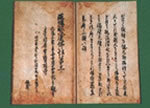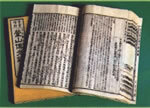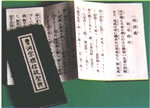Use of Cookies
Our website uses cookies to facilitate and improve your online experience.
Buddhism is a religion based on the teachings of the Buddha. For this reason, the words expounded by Shakyamuni Buddha have absolute authority and the sutras are collections of his sermons. “Sutra” is a Sanskrit word that referred in Brahmanism to those holy scriptures in which all sorts of teachings and regulations were recorded. This word is not unique to Buddhism and originally meant a “line” or “string.”
Following the death of Shakyamuni Buddha, his teachings were passed down from person to person by his disciples. However his disciples, concerned about the gradual changes in the contents of the teaching, gathered in a council to collect, organize, and correct the oral record of the Buddha's teachings.
At this council, the Buddha's successor (Mahakashapa) took a leading role. The sutras were corrected according to the memory of Ananda, who had the best memory of the Buddha's great disciples, and the precepts corrected according to the memory of Upali, who was said to have been preeminent in the practice of the precepts among the Buddha's great disciples. These records were put together by a large number of the Buddha's disciples who were, in this way, able to check and verify what had been heard as the Buddha's teaching and give their consent to it.
Finally, studies and commentaries on the sutras and precepts were made and called “sastras”. The all-inclusive term given to these three things (sutras, precepts, and sastras) is the “Tripitaka” or “three baskets,” in other words, containers in which the sutras, precepts, and sastras are stored.
Later, the total amount of Buddhist literature became extremely vast and for that reason was referred to as the “whole Buddhist canon.”
 The Shobogenzo is a collection of Dogen Zenji's teachings that were given between August 1231 and January 1253. As the title indicates, this book thoroughly covers the main point (eye) of the True Dharma that was inherited by the successive ancestors following Shakyamuni Buddha.
The Shobogenzo is a collection of Dogen Zenji's teachings that were given between August 1231 and January 1253. As the title indicates, this book thoroughly covers the main point (eye) of the True Dharma that was inherited by the successive ancestors following Shakyamuni Buddha.
Much of the book's contents are sophisticated teachings that express in Dogen Zenji's unique language his deeply enlightened mind. Even in modern times, this book is described as the greatest book on religious thought that has been produced in Japan.
The most common version of the Shobogenzo has 95 chapters. However, this edition was produced in 1690 by Dogen's Dharma descendants based on the idea that Dogen Zenji had originally intended the Shobogenzo to have 100 chapters.
There are two editions of the Shobogenzo that Dogen Zenji edited himself: one with 75 chapters and a later version with twelve chapters. It seems that his intention was to systematically organize these editions, and include other chapters. However, he died before he was able to complete this project. For that reason, there are various editions of the Shobogenzo that have survived to the present day, including 60 chapter and 28 chapter versions.
 The Denkoroku is a book of teachings that Keizan Zenji gave to the monks at Daijoji beginning in January 1300. He gave these teachings on behalf of his teacher, Gikai Zenji, and they were then brought together in book form by a priest who was close to Keizan Zenji. As this is a record of the teachings he gave, they were not written down by him.
The Denkoroku is a book of teachings that Keizan Zenji gave to the monks at Daijoji beginning in January 1300. He gave these teachings on behalf of his teacher, Gikai Zenji, and they were then brought together in book form by a priest who was close to Keizan Zenji. As this is a record of the teachings he gave, they were not written down by him.
The Buddha-dharma of zazen that originated with Shakyamuni Buddha was transmitted through India, China, and Japan by 53 ancestors until Keizan Zenji. The Denkoroku is a collection of teachings in which Keizan Zenji speaks about the way in which this Dharma was correctly conveyed. Each chapter deals with one of the ancestors in this lineage, quoting from their biographies, taking up the primary theme of their awakening to the Way, and the conditions that brought about their awakening. These are all brought together with Keizan Zenji's commentary, his admonitions to the monks, and a concluding verse.
This book is based on Dogen Zenji's teachings and since it traces the historical facts of the 53 ancestors who transmitted the teaching of Soto Zen, it is esteemed along with the Shobogenzo as one of the representative books of the Soto Zen School.
 The Shushogi is mainly comprised of extracts taken directly from the Shobogenzo. During the Meiji Period, there was a trend for each of the Buddhist sects to promote the tenets of their faith by adapting to the times. In the Soto Zen School, a committee was formed in which many priests and believers participated.
The Shushogi is mainly comprised of extracts taken directly from the Shobogenzo. During the Meiji Period, there was a trend for each of the Buddhist sects to promote the tenets of their faith by adapting to the times. In the Soto Zen School, a committee was formed in which many priests and believers participated.
One of them, a layman named Ouchi Seiran (1845-1918), served as the central person in putting together a work this committee published called Tojo Zaike Shushogi. The Soto Zen School thought this was excellent material for teaching laypeople and asked Takiya Takushu Zenji of Eiheiji and Azegami Baisen Zenji of Sojiji to check the contents of this work. On December 1, 1890, this work was distributed with the name Soto Kyokai Shushogi. This is the work that we now know as the Shushogi.
The tenets of Soto Zen School form a teaching that advocates the truly transmitted Buddha-dharma which has been correctly transmitted mind-to-mind from Shakyamuni Buddha throughout the successive generations of priests, only/just single-minded sitting (shikantaza), and “Mind itself is Buddha.”
The Shushogi teaches us how it is possible for us to practice this teaching mindfully in our everyday life and how to elevate our life of faith.
The Heart Sutra is a compilation of the essence of the massive 600 volume Great Wisdom Sutra. In only 262 Chinese characters, the profound thought of Buddhism and the attributes of vast compassion that are the basis of religious practice are concisely set out. This sutra is chanted by nearly all Buddhist groups in Japan.
Formally known as the Maka Hannya Haramitta Shingyo, this is a sutra that expounds the essence of the “Perfection of Great Wisdom.” Expressed within this sutra is the concept of “emptiness,” the central teaching of the Great Wisdom Sutra. This idea is concisely set forth in this sutra.
The idea of emptiness does not mean that there simply are no things or that everything is blank or void. Rather, this word includes the philosophical meaning that within things there is no fixed substance. Therefore, the meaning of the words “Form is emptiness, emptiness is form” is that forms (all objects that can be seen by the eye) are empty (eternally there is nothing that does not change) and emptiness (things that change, appear and disappear) is form (the world of objects).
There are said to be eight different translations of this sutra. Among them, the two that are best known are by Kumarajiva and Genjo. Genjo's translation is the one that became most widely used for chanting and is now the version generally referred to as the “Heart of Great Wisdom Sutra”, the Hannya Shingyo.